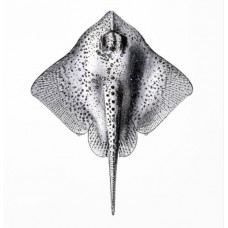Latin name
Amblyraja hyperborea
Other name
Amblyraja hyperborea
Identification
The broad and flat pectoral fins of the Arctic skate form a rhombic disk with a triangular snout and rounded edges. On the ventral side of the disk are 5 gill slits, nostrils and a mouth. The Arctic skate is similar in body shape to Amblyraja radiata, but differs in having a wider interorbital space and a more pointed snout. The dorsal surface of the disc is covered with small spines with a star-shaped base. The ventral side of the body is smooth. There is a continuous row of 22-30 large spines along the back, the tail is short.
Features of fish fins
These rays have 2 reduced dorsal fins and a reduced caudal fin.
Fish colouring
The dorsal side of the Arctic skate is dark, brownish-gray, sometimes with light spots. The belly of juveniles is yellowish-white, while adults are covered with dark spots and stripes, especially along the edges of the pectoral fins.
Distribution
This species is distributed in the Arctic, Indian, Pacific and Atlantic Oceans: in cold and deep waters; in the north of the North European Basin, in the area of the Faroe and Shetland Islands.
Habitat
These bathydemersal are found in the lower part of the continental slope at depths from 140 to 2500m, usually between 300 and 1500 m. They live on muddy substrates at temperatures below or slightly above 0°C. They are found at shallower depths in the northern parts of their range compared to the central and southern parts.
Size
The rays of this species are up to 65-70 cm long (up to 64 cm in the Barents Sea), but off the west coast of Greenland they reach larger sizes - males up to 86 cm, females up to 76.5 cm. The maximum recorded length is 106 cm.
Behavior
Arctic skates are most commonly found on deep slopes and at abyssal depths. They prefer polar temperatures from hatching to maturity, and eggs are successfully and regularly incubated in water as cold as 0°C. Juveniles tend to follow large objects, such as their mother.
Food and feeding habits
Bottom dwelling, benthophagous species. The Arctic skate feeds mainly on crustaceans and fish (Micromesistius, Molva, Gobiidae and Lycodes).
Reproduction
These rays lay eggs enclosed in a horny capsule with protrusions at the corners. The capsule is 8-12.5 cm long and 5-8 cm wide; the projections on one side are much longer than on the other. Juveniles are about 16-18 cm long after hatching. Males reach sexual maturity at a length of about 120 cm. Males reach sexual maturity at a length of 86-93 cm. The smallest free-swimming individual was 23 cm long.
Fishing
These rays are not targeted. They are caught as by-catch in the cod fishery.
Relationship with a person
Harmless to humans is a species of fish. The meat of these stingrays is floppy and unpalatable.
| Classification | |
| Phylum | Chordata |
| Class | Chondrichthyes |
| Squad | Rajiformes |
| Family | Rajidae |
| Genus | Amblyraja |
| Species | A. hyperborea |
| Features | |
| Conservation status | Least Concern |
| Habitat | Bottom |
| Life span, years | No information |
| Maximum body weight, kg | No information |
| Maximum length, cm | 106 |
| Sailing speed, m/s | No information |
| Threat to people | Not edible |
| Way of eating | Predator |
Arctic skate
Tags: arctic skate

